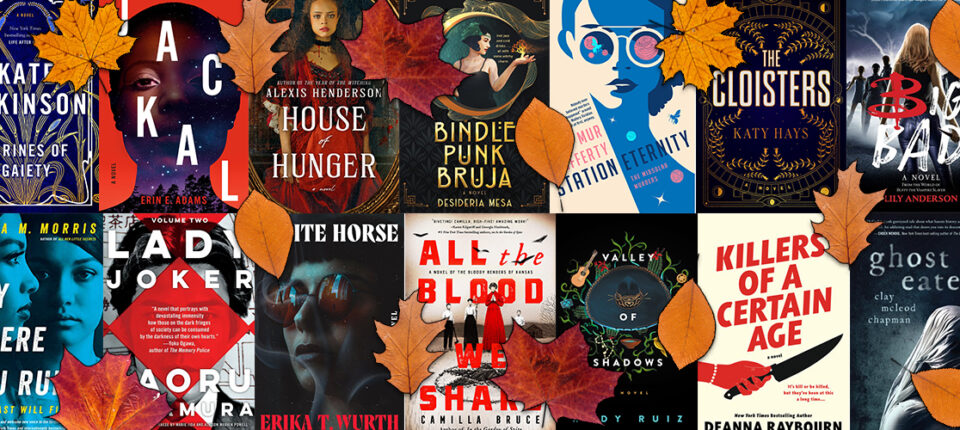It may not be cooling down yet, but it’s gothic season, baby! And dark academia season, and social horror season, and folk horror season, and winter thriller season, and contemplative psychological suspense season—those are just a few of the trends I’m seeing in the books coming out over fall and winter. For more cozy fireside reading, there’s also plenty of fair play mysteries and historical fiction to round out the end of your year, with a few nonfiction titles sprinkled in. I’ve also included more of a sneak preview of next year’s titles than usual for a fall reading list, but that’s because I and my fellow CrimeReads editors just couldn’t wait to talk about them. As is the case every time I put this list together, I’m astounded by the wondrous titles coming out in such a dark time in the world, but perhaps that’s because we need good books now, more than ever.
___________________________________
SEPTEMBER
___________________________________
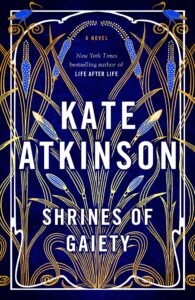
Kate Atkinson, Shrines of Gaiety
(Doubleday)
What could be better than a new Kate Atkinson novel? How about a new Kate Atkinson novel set in the past?!? Atkinson heads to the Roaring 20s for her upcoming literary novel with elements of crime. Shrines of Gaiety explores the peaks and nadirs of life in the demimonde-neighborhood of Soho, where the upper crust rubs shoulders with the down and out and the criminally successful. A perfect companion tale to Fiona Mosley’s well-received story of sex workers in modern-day Soho, Hot Stew. –MO

Kelly J. Ford, Real Bad Things
(Thomas & Mercer)
Ford’s 2017 novel, Cottonmouths, remains a standout in the suspense category, and she’s back this year with a powerful story of a young woman who confesses to the murder of her stepfather. Rather than going to jail, she carries on with her life, moves away, starts over—because the police never actually found the body. Two decades later, the corpse turns up, and she’s forced to return to her hometown in Arkansas to reckon with her past and what’s left of her family. –DM

J. M. Lee, Broken Summer
Translated by An Seon Jae
(Amazon Crossing)
In this moody psychological thriller, an artist wakes up one morning to find his wife, who also handled all of the business aspects of his work, has disappeared and left a novel in her place, told from the perspective of an artist’s wife who finds her husband decidedly ungrateful for all that she does for him. –MO

Sally Thorne, Angelika Frankenstein Makes Her Match
(Avon)
Angelika Frankenstein Makes Her Match is an historical rom-com with monsters—a “mon-com”, if you will—and an extremely funny one at that. Angelika Frankenstein, frustrated in love and facing a future as a spinster aunt to her brother Victor’s children, decides to assemble the perfect man from a panoply of recently deceased parts, including the handsomest face (and the second-largest penis) in the morgue. While her new husband’s body makes it clear he’s attracted to her, Angelika’s monster is just too much of a gentleman to act on his desires, and Angelika is getting rather frustrated indeed… –MO
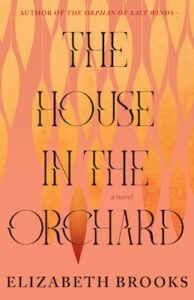
Elizabeth Brooks, The House in the Orchard
(Tin House)
The House in the Orchard is a richly-layered gothic novel with all the psychological penetrations that form is so celebrated for. We follow a WWII widow to a country estate in disrepair, and then a book is found—a young girl’s diary—and soon we’re thrown into another story, of an orphaned child trying to interpret her own trauma and the events of the adult world around her. The result is an exercise in disquiet, just as a good gothic novel should be, and a haunting tale of loss and discovery. –DM

Virginia Hartman, The Marsh Queen
(Gallery)
In this deeply emotional debut, a woman is pulled out of her life working as a nature artist at the Smithsonian and called back to her hometown in Florida, following her mother’s accident. But it’s the mystery of her father’s long-ago death that captures her imagination and drives this story forward: a strong, simmering story of family loyalty, strife, and secrets.–DM

Marcia Clark, The Fall Girl
(Rare Bird)
In Clark’s latest, a clash of personalities brings new tumult to the Santa Clara DA’s office and exposes corruption in the California criminal justice system. Clark has a savvy hand with the dramas of prosecutorial life and a knack for drawing sharp, interesting characters. –DM

Alexis Henderson, House of Hunger
(Ace)
In this lush reimagining of the Elizabeth Bathory story, a young woman languishing in poverty in an industrial city gets a chance to become a Bloodmaiden to the elite aristocrats whose salacious appetites include a taste for the blood of their own constituents. Some Bloodmaidens go on to lucrative fortunes and comfortable retirements, but as Henderson’s heroine adjusts to her new life as Bloodmaiden to the most powerful aristocratic house in the kingdom, she soon realizes that being slowly consumed by those more powerful than you is rarely a recipe for long-term satisfaction. –MO

R.J. Jacobs, Always the First To Die
(Sourcebooks Landmark)
Another hurricane thriller! Nothing sets up the perfect conditions for a locked room mystery like being trapped in the Florida Keys, especially if you’re there to rescue your daughter from your horror film producer father-in-law, who’s trying to repeat both the success and sacrifices of his most famous production. Also, there’s an unstable actress ready to sue the production and convinced that someone’s trying to kill her. And that husband who went missing a year back? Maybe you’re about to find out why. Fans of horror cinema will enjoy the meta-textual elements of the novel, as the characters frequently discuss not just scary movies, but the nature of fear itself. –MO
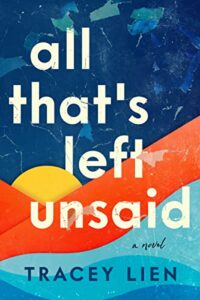
Tracey Lien, All That’s Left Unsaid
(William Morrow)
I know I compare a lot of books to the movie Paris, Texas, but that’s just what I think of when there’s an epic emotional confrontation between two characters after a long search for answers. All That’s Left Unsaid is set in an Australian neighborhood celebrated for being a vibrant hub of refugee Vietnamese culture, and notorious for widespread drug use and gang violence. A young woman returns home to investigate the murder of her brother, a teenager who was beaten to death at a local restaurant. Traumatized by their wartime experiences and the indifference of the police, the restaurant’s patrons refuse to share what they witnessed. It’s up to Lien’s determined protagonist to answer two questions: why was her brother killed, and why didn’t anyone stop it? Her investigation soon becomes a wider effort to understand the gaps between her parents’ generation and their Australia-raised children. –MO
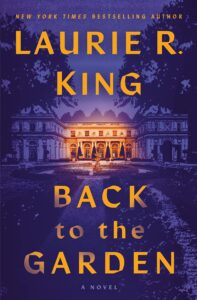
Laurie R. King, Back to the Garden
(Bantam)
A California mansion-turned-commune-turned-art-museum is the setting for Laurie R. King’s wondrous return to a San Francisco setting. When rains damage a statue on the grounds, the skeletal remains of a young woman are found beneath it, and another shocking discovery is made: the statue itself is incredibly valuable. Both the statue and the murder date back to the mansion’s commune days, well-preserved in the archives and less well-preserved in the memories of those who lived there (but lucky for us, we get flashbacks!). –MO

Rita Cameron, The House Party
(William Morrow)
This impeccably plotted thriller is set in the lead-up to the 2008 housing crash, and features the haves and have-nots of a Pennsylvania exurb pitted against each other when an out-of-control party ends in the complete destruction of a newly constructed house. Through multiple points of view, we see the wild party, its devastating aftermath, and its many uneven consequences. –MO
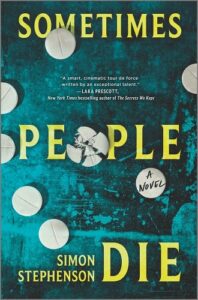
Simon Stephenson, Sometimes People Die
(Hanover)
Simon Stephenson’s diabolical and quick-witted medical thriller is not to be missed, unless you are a person who already has trouble trusting doctors, in which case, do not read this book. But for those of us who are perfectly happy to place our lives in the hands of the medical establishment, Sometimes People Die is a rather hilarious delight. In an underfunded and understaffed hospital, a doctor with a history of opiate abuse has been given a second chance at curing people. Unfortunately, one of his colleagues is more interested in playing god than healing people, and it’s up to the formerly disgraced doctor to find the real culprit for the hospital’s growing number of suspicious deaths, or find himself under investigation. While this book is rather disturbing, an American reading about even the worst parts of the NHS is still bound to be impressed in contrast to our own terribly fraught system. –MO

Desideria Mesa, Bindle Punk Bruja
(Harper Voyager)
Bindle Punk Bruja is as cool as its title, featuring a fast-talking flapper who runs a gin joint with the best jazz band in town, and keeps her bar safe from interference with earth magic learned from her Mexican mother. Mesa’s heroine also dabbles in sex magic, dropping each man as they get too attached, but as the silky smooth plot of BPB progresses, finds herself falling for a tattooed piano player with ties to Al Capone. Oh, and she’s involved in a gang war, while trying to keep her Mexican heritage a secret and use a sham marriage to secure a business loan. BPB is full of the spirit of the Jazz Age told from a rare and adventurous perceptive. –MO
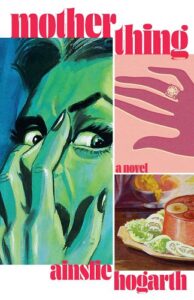
Ainslie Hogarth, Motherthing
(Vintage)
What happens when your nightmarish mother-in-law does what she’s been threatening to do and dies in a very messy manner? First, you clean up the blood. Second, you try to convince your husband to move. And third, when he refuses, you settle down to a new life doing battle with the vengeful spirit of said mother-in-law who is now haunting the house. –MO
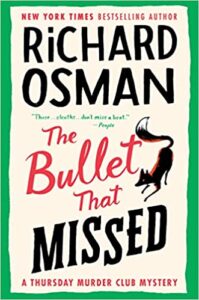
Richard Osman, The Bullet That Missed
(Pamela Dorman/Viking Books)
I adore the first two Thursday Murder Club books with all my heart. If you, like me, have been taxing your patience, crawling up the walls in wait for the next installment, you won’t be in agony for much longer, and your patience will be rewarded. Number Three in the series about the residents of a retirement community who transition from discussing cold cases to solving real murders, might be the most fun book of them all. It’s called The Bullet That Missed, and it sets our beloved Thursday Murder Club members against spies, mysterious assignments, television personalities, and of course, several dead bodies. A hilarious, gripping new tale, it is worth waiting for, and not to be missed! –OR
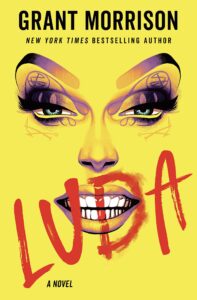
Grant Morrison, Luda
(Del Rey)
Grant Morrison’s Luda is like no other book I’ve read. An aging drag queen takes a struggling performer under their wing, only to find themselves slowly and steadily overshadowed by the magic of their protege as the two star in a doomed pantomime production of 1001 Nights. Luda is equally playful with both genre and gender, exploring the flowing instability of identity and presentation. This stylish, glittering novel is not to be missed. –MO

Rudy Ruiz, Valley of Shadows
(Blackstone)
Ruiz’s latest is a chilling meditation on life and death in the 1870s borderlands between the US and Mexico, a neo-western that brings a fatalistic noir sensibility to a story with deep spiritual and literary roots. –DM

Hiron Ennes, Leech
(Tordotcom)
In a post-apocalyptic future, health care is free for all—and provided by human bodies controlled by alien minds, who meld their knowledge to serve their patients. One has died mysteriously in the far northern mining towns, and another has been dispatched to learn the cause of death. When the doctor plucks a worm from behind the eye socket of his predecessor, he realizes he is dealing with no raw pathogen, but instead, a sophisticated competitor. –MO
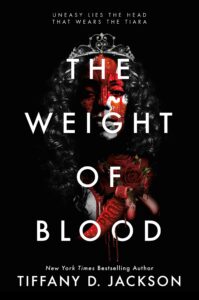
Tiffany D. Jackson, The Weight of Blood
(Katharine Tegan Books)
Tiffany D. Jackson takes the already brilliant story of Carrie and turns it into a commentary on American racism in this perfect social thriller. Maddy Washington is mousy, frequently bullied, and passing as white. When her mixed parentage becomes known to the school, the bullying turns into outright racism. Meanwhile, Maddy’s school has held two proms—a Black prom and a white prom—since the 1960s, and the bad press from videos of racist incidents surfacing convinces a popular white girl with a Black boyfriend to propose integrating the prom. Because this book is based on Carrie, we all know what happens at the prom…but how do they get there? Jackson blends old and new elements impeccably for what might be the most entertaining and thought provoking work of the season.–MO
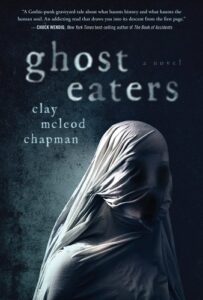
Clay McLeod Chapman, Ghost Eaters
(Quirk)
What if you could take a drug that showed you the souls of those who haunted you? And what if you took too much of that drug, and started seeing the dead everywhere? In Ghost Eaters, a group of college friends is left bereft when one of them overdoses, but taking a drug called Ghost may help them talk with their lost friend once more. Chapman sets his novel in Richmond, Virginia, and this Southern Gothic ghost story uses its setting well to explore the not-even-past history of the South. –MO
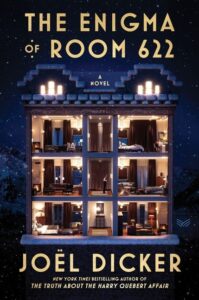
Joel Dicker, The Enigma of Room 622
(HarperVia)
A new meta-mystery from the Swiss author unfolds with uncanny precision and evolves from a hotel whodunnit into something more nebulous. The elegant surroundings bring to mind classic mysteries, with notes of subversion peppered throughout. –DM
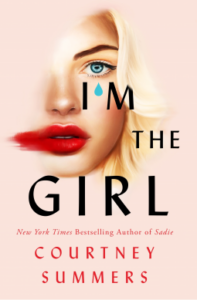
Courtney Summers, I’m the Girl
(Wednesday Books)
Courtney Summers’ new book is about Georgia, nicknamed George, beautiful, vulnerable, and powerful, on the cusp of making a choice that many of us have been forced to make: to support other women and fight for bodily autonomy, or to enforce the patriarchy and accept its barbed rewards. But rewind here: what actually happens in this book? So, George finds the body of a 13-year-old girl, and starts investigating the murder with Nora, the victim’s sister, who’s also a burgeoning love interest. Meanwhile, George goes to work in the small town’s high class hotel and club, which is also the town’s main source of income. She gets close with the couple that own the establishment, but is she willing to do what is necessary to secure her position with her new friends? Summers is an astute observer of power and its discontents, and in I’m The Girl, she’s written an unforgettable work of biting social criticism. A perfect read for angry women. –MO

Jonathan Ames, The Wheel of Doll
(Mulholland Books)
This follow-up to A Man Named Doll brings much of the same uncanny energy—raw violence, hard-boiled humor—with a new dash of pathos, as Doll goes on the search for an old flame he believed dead. Ames, as ever, plays with the full range of hardboiled tropes and brings out fresh nuances and something really quite startling in this contemporary PI novel. –DM

Rijula Das, Small Deaths
(Amazon Crossing)
Rijula Das’ sweeping novel of sex workers and the quest for human dignity is bitterly cynical, surprisingly humorous, and astonishingly beautiful. Lalee lives and works in Calcutta’s red light district, where she barely scrapes by. The murder of a popular courtesan is a chance to note the indifference of police, but gives her an opportunity to assume the dead woman’s life and clientage. Will she lose herself in the heady world of the elite? Or will she face dangers that she could never imagine? Why was the elite sex worker murdered, and what did she know about the underworld of human trafficking? And what part in the novel’s explosive conclusion will a bumbling, erotic-fiction-writing patron play? Some novels about sex workers can feel moralistic and exploitative in their brutality; here, we have the opposite—a deeply human portrait of a wide swatch of Calcuttan society working hard to survive and preserve their dignity and community. –MO

Stephen King, Fairy Tale
(Scribner)
This new Stephen King fantasy novel is bringing me right back to my childhood. It’s big (608 pages!), it’s magical (a portal to another world in the backyard!), it’s epic (a boy and his dog leading the fight against evil). Just what I need to help me escape this hellish timeline for a little while. –Emily Temple, Lit Hub managing editor
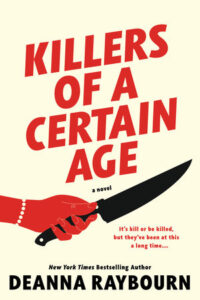
Deanna Raybourn, Killers of a Certain Age
(Berkley)
As the tag-line for this incredible series launch reminds us, women of a certain age may be invisible to society, but sometimes, that’s their greatest asset. As Killers of a Certain Age begins, four trained assassins are readying for their retirement after four decades of taking out terrible people in a most elegant manner. Unfortunately, their bosses have planned a rather more permanent end to their careers than they would like, so the women must go rogue and take on their former employers to find out why they’re been selected as targets. The lively banter between old friends, mixed with plenty of action sequences, will keep you turning the pages long into the night, and I’m hoping these feisty heroines make it to the screen soon to continue their adventures. –MO

Chloe Gong, Foul Lady Fortune
(Margaret K. McElderry Books)
This historical fiction YA is set in 1931 Shanghai and features two pairs of spies—one nationalist, the other communist—as they go deep undercover and try to prevent the coming Japanese invasion. Chloe Gong adds in magic, romance, and supernatural killings for one of the best cross-genre works I’ve read. A fast-paced, tightly-plotted delight of an espionage novel. –MO
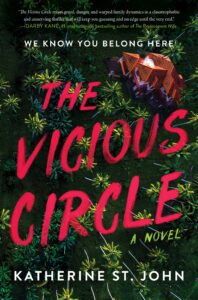
Katherine St. John, The Vicious Circle
(William Morrow)
In this wellness industry thriller, a New York model travels deep into the jungle to her uncle’s paradisiacal retreat, left to her in his will after his unexpected passing. There, she’ll have a showdown with her uncle’s consort over who can lay claim to the dead guru’s legacy (and property). Was her uncle truly interested in healing, or did he create an isolated cult that’s one spark away from imploding? What’s in that weird tea that people keep making her drink? And is that jaguar really domesticated, or just waiting to feed on the next errant cult member? –MO

Lily Anderson, Big Bad
(Hyperion Avenue)
The Buffyverse is back! But this time, with one major twist: Sunnydale is now Demondale, a town where all the Buffy villains coexist in harmony under a permanent night sky. That is, until the Slayer gets transported from her dimension into theirs, and decides she has to destroy their entire world in order to get back to hers. Andrew, Jonathan, Anya, Angel, Faith, the Mayor, and the First Evil—they’ve all got to band together and defeat the slayer, or face the eradication of their own existence and that of everyone they love (or, you know, wanted to murder eventually). Lily Anderson, a self-described superfan of the Buffy franchise, delivers a loving tribute and delightful twist on the characters we all know and love. –MO

Joe Pompeo, Blood and Ink: The Scandalous Jazz Age Double Murder That Hooked America on True Crime
(William Morrow)
The 1922 murder of a prominent reverend and a woman from the church choir serves as the basis for Pompeo’s Blood & Ink, which takes a fresh look at the grisly murder. A new media landscape was emerging at the time of the crime, and Pompeo does an admirable job of linking up the mystery to the wider cultural forces at play. –DM
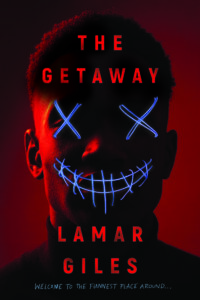
Lamar Giles, The Getaway
(Scholastic)
In this social horror thriller set in an evil post-apocalyptic Disneyland, a battle between the haves and have-nots is brewing. The resort setting of The Getaway used to be just a place for rich people to vacation, but suddenly, the world is in disarray, the compound is locked down, and the theme park’s staff are now being used as the upper crust’s playthings, to dispose of at will. This revolutionary YA thriller is as rousing as it is prescient (with plenty of surreal humor thrown in). –MO

Stacey D’Erasmo, The Complicities
(Algonquin)
In Stacey D’Erasmo’s latest novel, Suzanne’s wealthy, comfortable world shatters after the revelation of her husband’s financial crimes. When he’s sent to prison, she tries to rebuild her life and create a new identity in a small beach town, severing all ties with him. Upon his release, with the demands for restitution coming from those he harmed, Suzanne must grapple with her own complicity–and what to do about it. Samantha Hunt calls The Complicities a “gripping, human tale of our crimes—financial, environmental, self-delusional” that is “impossible to put down.” –Jessie Gaynor, Lit Hub senior editor
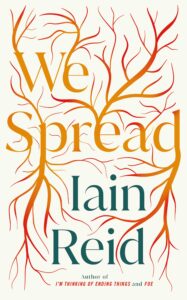
Iain Reid, We Spread
(Scout)
Iain Reid’s creepy and unsettling novel is about an aging artist who finds herself forgetting things and losing her grip on reality at the long-term care facility where she now resides, wondering if she’s deteriorating naturally or if something sinister is being done to her. As moving as it is terrifying.–OR
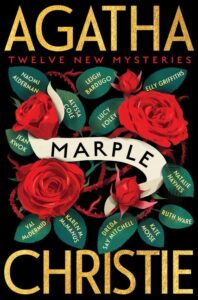
Marple: Twelve New Mysteries
(William Morrow)
Miss Marple is back (or at least rebooted) in this collection of twelve new short mysteries written by some of the best mystery writers today, from Ruth Ware to Val McDermid to Lucy Foley to Elly Griffiths to Alyssa Cole. –OR
___________________________________
OCTOBER
___________________________________

Wanda Morris, Anywhere You Run
(William Morrow)
Wanda Morris burst onto the scene last year with her impeccably plotted legal thriller, All Her Little Secrets, and her new novel keeps a legally-minded heroine as one of its leads but takes us back to 1964. When Violet Richards is raped by a white man, she takes her revenge, then goes on the run, soon followed by her sister Marigold, who aspires to be a lawyer but first must make a decision about her unwanted pregnancy. A southern setting where voting and abortion are both increasingly restricted feels…rather like today, if I’m honest. Wanda Morris, too, has noted the parallels, and there is a sense of political urgency that helps speed this thriller along. –MO
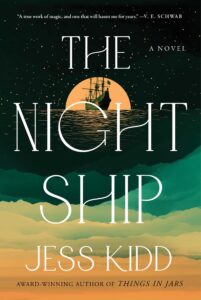
Jess Kidd, The Night Ship
(Atria)
Jess Kidd is one of those rare authors that truly inhabits the worlds they write about, creating richly textured historical tales full of terrible smells and grand adventures. In The Night Ship, Kidd weaves back and forth between a young girl on a Dutch ship bound for far away ports and an adolescent boy on an island with a mysterious and violent history. Eventually, these two stories will intersect, as the fate of the ship, and the boy on the island, are slowly revealed. It’s hard to do justice to Kidd’s delightful, yet at times heart-rending, and utterly idiosyncratic style. –MO

Erin E. Adams, Jackal
(Ballantine)
As Jackal begins, Liz Rocher has reluctantly headed home to Johnstown, Pennsylvania for her childhood best friend’s wedding. She’s prepared for the micro-aggressions from her friend’s racist family, but during the celebration something far worse happens—a beloved child goes missing, and the key to her disappearance stretches back over decades of missing children, all of them young Black girls last seen around the summer solstice. Meanwhile, a spirit in the woods is close to taking corporeal form and rejecting the bonds of its human master. A social thriller perfect for fans of Jordan Peele, Jackal also comfortably rides the folk horror wave. Like Bethany C. Morrow’s Cherish, Farrah, Jackal also asks compelling questions about who society values as worthy of protection, and the true nature of monstrosity. –MO
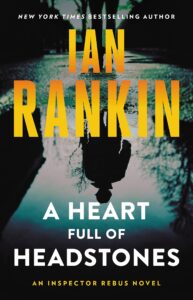
Ian Rankin, A Heart Full of Headstones
(Little, Brown)
S**t gets real in Rankin’s latest, opening with John Rebus in court as the defendant (the reason won’t be revealed till the last chapter). Rebus spends much of the book doing a favor for his old nemesis Cafferty, but he’s also investigating a cop who’s been abusing his wife. Another strong installment of a beloved series. –MO

Joanna Margaret, The Bequest
(Scarlet)
This debut from art historian Joanna Margaret hopscotches across European art and academia hot spots and delivers on a wild ride with nods to gothic fiction and dark academia, accompanied by smart notes of Hitchcock to round out this exemplary thriller. With a doctoral candidate at the center of the plot, you can expect an erudite unraveling of the mystery, as well as some pressure cooker atmospherics from some of the grandest spots on the international intellectual circuit. –DM

Kaoru Takamura, Lady Joker
Translated by Allison Markin Powell and Marie Iida
(Soho)
I’m a big fan of big novels, and Kaoru Takamura’s Lady Joker is an epic for the ages. The first installment of 500+ pages took us into a fictionalized account of an industrialist’s kidnapping that captivated Japanese media for upwards of two years in the mid-90s. Now, we get to read the impeccably translated followup as Takamura continues to weave together elements of crime, social criticism, and literary epic. I described the first one as James Ellroy if written by Don Delillo, and I stand by that comparison. –MO

Vinaya Bhagat, The Girl in the Mist
(Agora)
This spooky supernatural thriller dives deep into India folklore with a modern update to the legend of the Chakwa, a kind of shape-shifting trickster that can bring blessings—or curses. After Vinaya Bhagat’s narrator loses her parents to a tragic car accident, she heads to India to get to know her distant family, but soon finds herself at the center of a web of mysterious attacks and even more mysterious legends. –MO
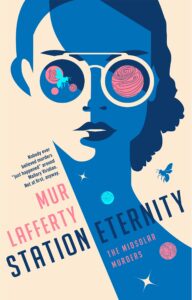
Mur Lafferty, Station Eternity
(Ace)
This book is so much fun. What if Jessica Fletcher’s tendency to have people die around her had led to instructions to self-isolate for the benefit of society? And what if that isolation had taken place on a space station rather like Babylon Five? In Station Eternity, a young woman who has solved a suspicious number of murder mysteries flees police attention on Earth and heads to a space station with few other humans on board. Of course, someone on board the space station would have the temerity to be murdered, and once again, all signs point to Lafferty’s protagonist unless she can solve the crime herself. –MO
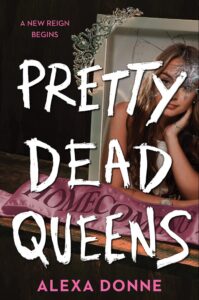
Alexa Donne, Pretty Dead Queens
(Crown Books for Young Readers)
In this very fun mystery that’s also a profound exploration of grief, Alexa Donne takes inspiration from Murder, She Wrote, in which Jessica Fletcher’s nieces and nephews always seem to get into some kind of trouble while visiting her. Pretty Dead Queens asks, what if a highly successful mystery author with a murky past had her grieving teenage granddaughter move in, and what if that girl then decided to investigate a cold case from her grandmother’s high school days while a copycat killer roamed the streets? –MO
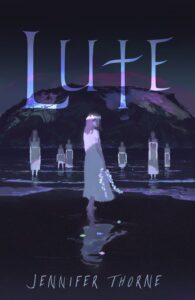
Jennifer Thorne, Lute
(Nightfire)
In this excellent new folk horror from Jennifer Thorne, a newcomer to an island experiences an ancient, bloody tradition for the first time. Every seven years, people on the island find themselves in danger of accidental death for one day. These deaths are said to bring prosperity and health to the island’s residents, many of whom are off fighting in a fierce war, and the island’s people are loath to experience any disruption to their ritual for fear of risking those abroad. The ending felt very Ryan Murphy, by which I mean, both horrifying and sweet. –MO
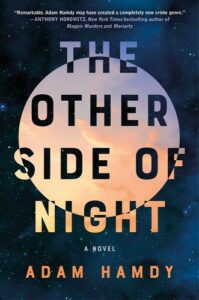
Adam Hamdy, The Other Side of Night
(Atria)
With The Other Side of Night, Hamdy has crafted an intricate, exhilarating mystery that makes it feel as though the ground is shifting beneath your feet. A man’s deepest regret, a note in a used book, a detective with unexpected links of her own to the case—this one will leave readers short of breath and eager for more.–DM
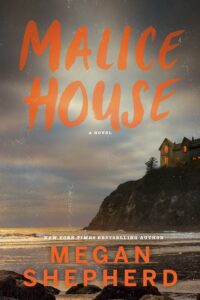
Megan Shepherd, Malice House
(Hyperion)
Haven Marbury is broke, stuck cleaning out her recently deceased father’s home in a depressing seaside town and unable to move on from a bad relationship without sufficient funds. She thinks she’s found the answer to her money problems when she comes across an undiscovered manuscript of rather disturbing short stories by her father, whose literary star was such that a previously unpublished collection should bring untold riches. Haven’s an illustrator, so she decides to illustrate the stories. But unfortunately for her (and fortunately for readers) those illustrations may be a portal to another world where nightmares are real and only waiting to cross into this one…An excellent addition to the growing gothic revival. –MO
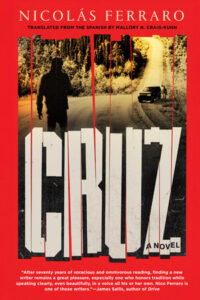
Nicolas Ferraro, Cruz
Translated by Mallory N. Craig-Kuhn
(Soho)
A vivid, bloody noir set amidst prison and gangland violence in northern Argentina, where two brothers swear themselves to different paths and wrestle with their father’s violent legacy. –DM
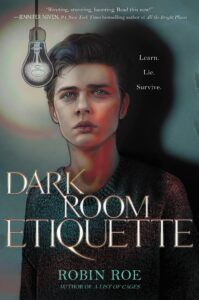
Robin Roe, Dark Room Etiquette
(Harperteen)
Robin Roe is a former counselor for at-risk youth who knows what she’s talking about when it comes to trauma and young adulthood. In Dark Room Etiquette, she sets out to show the long-term emotional consequences of a horrific event. A privilege high schooler is kidnapped and develops Stockholm Syndrome; the story of his captivity is rent with twists and turns and ends on a surprisingly hopeful note. If you are seeking emotional catharsis, read this book. –MO

Lev A. C. Rosen, Lavender House
(Forge)
In the midst of an America under the sway of McCarthyism, a gay policeman gets caught in a raid on an underground club and finds himself at loose ends and newly a pariah. Rescued from suicidal ideation by the wealthy owner of a soap dynasty, he accepts a commission to investigate a murder in a house where everyone is queer, including the servants and the victim. Lavender House, an art deco mansion in a secluded area outside of San Francisco, is more than just a refuge for those who would live openly as gay, and as the ex-cop uncovers its secrets, his own life becomes more and more in danger. –MO
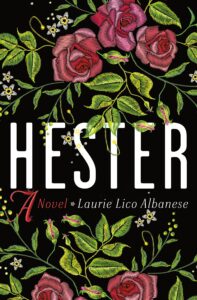
Laurie Lico Albanese, Hester
(St Martin’s Press)
Laurie Lico Abanese’s Hester is a beautifully imagined historical origin story for Nathaniel Hawthorne’s Scarlet Letter, following a Scottish immigrant dressmaker to the New England colonies whose friendship with Nate Hawthorne is the subject of some scandal about town. Albanese’s heroine is a proud descendent of a woman accused of witchcraft who evades her captors and births a strong line of take-no-prisoners women. Perfect for those who understand that any work that explores the pernicious accumulation of small town nastiness is basically just a psychological thriller anyway. –MO
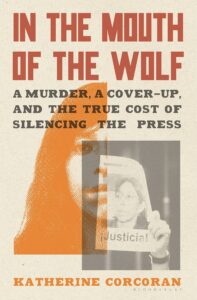
Katherine Corcoran, In the Mouth of the Wolf: A Murder, a Coverup, and the True Cost of Silencing the Press
(Bloomsbury)
A powerful chronicle of the life, work, and murder of Regina Martínez, a trailblazing journalist whose stories in Proceso exposed major corruption in the ranks of Mexican politics, and who was brutally killed in 2012. Corcoran, AP bureau chief in Mexico at the time of the killing, trains a sharp investigative eye on the events leading up to the murder and the desperate coverup that ensued. –DM
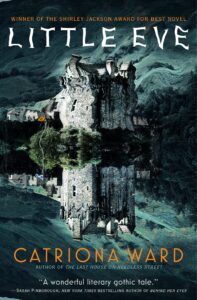
Catriona Ward, Little Eve
(Tor Nightfire)
Little Eve is so creepy! If you like reading about snakes, apocalypse cults, Scotland, or disturbing little girls, then Little Eve should be just your Halloween-season cup of tea (coolaid?). Catriona Ward has consistently impressed me with her atmospheric gothics, and her latest can only add to her growing reputation. –MO
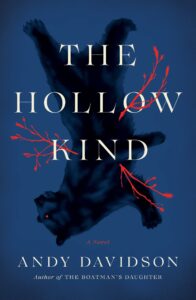
Andy Davidson, The Hollow Kind
(MCD)
A creaky old family mansion, a blood lineage, and the weight of ancestors’ wrongdoing—who could ask for more in a ghost story? But there is more, and then some, in The Hollow Kind. Nellie Gardner needs to escape from her abusive marriage, and when she finds out that her grandfather willed her the family estate, and she and her 11-year-old son immediately flee to their new home. It doesn’t take long for them to realize they are in a different kind of danger on the property: something is at work in the land, and in the house, a corrupted soul, an ancient hunger for blood, for evil. The Hollow Kind is more than a ghost story: it is a reckoning with the fact of money, land, power, and the darkness that looms in family history. –Julia Hass, Lit Hub contributor
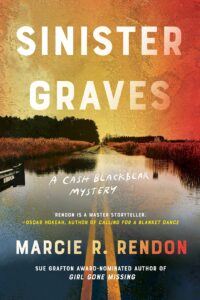
Marcie R. Rendon, Sinister Graves
(Soho)
A drowned woman in a drowned land: that’s how Marcie R. Rendon’s third novel begins, as water recedes from the Minnesota landscape after a huge snowmelt, and a young Ojibwe woman is found murdered. Cash Blackbear, an Ojibwe college student, decides to seek her own answers in the case, following the victim’s trail to an evangelical church that feels more like a cult than a house of worship. Once again, Rendon immerses us in the 1970s Midwest and gives readers a plot to carefully consider. –MO
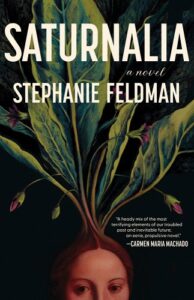
Stephanie Feldman, Saturnalia
(Unnamed Press)
In a near-future Philadelphia, the last week of the year is spent carousing and upending all of society’s conventions—a necessary means to let off steam in a climate-changed world wracked by storm, fire, and frost. Elite social clubs rule the week of Saturnalia, with their debauched festivities and sophisticated membership; Nina, a card-reader who once belonged to the most prestigious of them all, is recruited by an old friend to uncover the club’s secrets at their most legendary party. Taking place over one evening, this book should be devoured quickly, like the sinful treat that it is. –MO

Claudia Lux, Sign Here
(Berkley)
Looking for a fun Halloween-y book that feels like a mash-up between The Good Place, Succession, and The Office? Well, hopefully now you are, because there is one, and it is very funny. Sign Here features a white collar worker from Hell who’s working as hard as he can to sign away an entire family’s souls (once he does, he gets a bonus). But as his targets decamp to their lake house for a long, fraught, summer, the job may be more difficult than he imagined. –MO
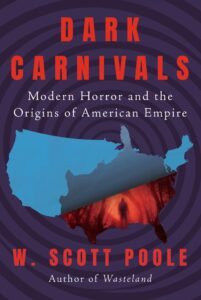
W. Scott Poole, Dark Carnivals: Modern Horror and the Origins of American Empire
(Counterpoint)
This book’s thesis is quite fascinating: W. Scott Poole writes of horror cinema, fiction, and culture as a path towards obliquely understanding an America that is an empire, and deliberately blind to this fact. He sets up two opposing narratives of horror: the Jaws story, where we are all happy in a 1950s America where threats come from the outside, attack us arbitrarily, then are defeated with order restored, and The Texas Chainsaw Massacre narrative, where the cannibals have made a mockery of American manifest destiny and the naïveté of the teenage victims is such they almost deserve their suffering. There is no more vibrant field of criticism than writing on horror, and Dark Carnivals is a worthy addition to a growing field. –MO
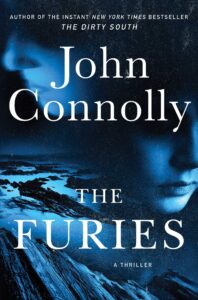
John Connolly, The Furies
(Atria)
John Connolly has written his own peculiar supernatural version of the pandemic novel, in which a deadly newcomer arrives in Portland, Maine seeking vengeance against his old lovers, the sisters Strange. Charlie Parker teams up with the mysterious sisters as they use their own powers to head off their attacker. Sure to give you chills, in the way only John Connolly can! –MO

Ava Barry, Double Exposure
(Pegasus)
Double Exposure looks so intriguing! Four years after an LA heiress is attacked and her parents are murdered, she returns to the city, but the threatening messages she’s been getting are getting in the way of the healing process. A PI comes on scene to help find the culprit, but instead, finds herself getting way too entangled with the heiress, and perhaps complicit in keeping her family’s dark secrets. –MO

Robert J. Lloyd, The Poison Machine
(Melville House)
In this follow-up to his well-received The Bloodless Boy, set in the midst of the scientific revolution, Robert J. Lloyd takes his scientist-detectives Harry Hunt and Robert Hooke all over Restoration England on a mission to avert an assassination plot against the Queen. Lloyd once again infuses his world with the sights, sounds, and smells of the late 17th century, as well as immersing readers in the thriving scientific debates of the time, for what’s bound to be one of the best historical novels of the year. –MO

Lee Child and Andrew Child, No Plan B
(Delacorte)
The “Child” brothers keep powering along, and their collaboration is bringing a new energy to the beloved Jack Reacher series (which is also flush with new fans in the wake of the hit adaptation). No Plan B has all the staples we’ve come to appreciate: a small-town, arrived to seemingly at random, but soon Reacher finds a conspiracy unfolding, as a series of ‘accidental’ deaths have something more sinister behind them. Reacher, naturally, will apply brutal reason (and other brutal forces) to find his way into the depths of this small town’s corrupt soul. –DM

Kevin Chen, Ghost Town
(Europa)
Ghost Town is an impressive, sweeping tale centered around a large, traditional Taiwanese family, the Chens, whose second-oldest child Keith once ran away to Berlin to escape oppression for his sexuality, and is finally returning, a decade later, after having served time for the murder of his boyfriend. But that isn’t the whole story—and together, the Chens (living and dead) piece the story—of their son, of all their family—together.–OR

Kris Waldherr, Unnatural Creatures
(Muse Publications)
Quiet, people! Listen up! We’ve got a Frankenstein adaptation on this list! Kris Waldherr reimagines the story of the doomed scientist and his abandoned creation from the perspective of three women in his life.–OR
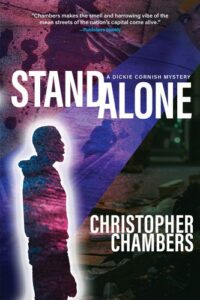
Christopher Chambers, Standalone
(Three Rooms Press)
Christopher Chambers stunned me with his hard-hitting debut, and now his street-living detective is back to track down a missing girl, who may be just one of a whole bunch of missing children. You can’t get bleaker than Chambers, and that’s certainly a compliment. –MO
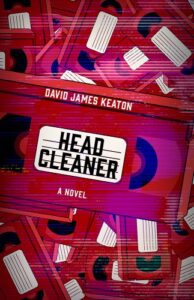
David James Keaton, Head Cleaner
(Polis)
This one’s described as “Clerks meets Black Mirror” which is pretty much all I need to know to add it to my reading list. Perhaps recommending this book…is a form of quiet quitting? Perfect for those who enjoy reading about, er, being a cog in the system, with a strong dose of horror thrown in! –MO

Ana Davila Cardinal, The Storyteller’s Death
(Sourcebooks Landmark)
Isla Larsen Sanchez has spent most of the summers of her youth in Puerto Rico with her grandmother and great-aunt. But when she is eighteen, her grandmother, a “cuentistas” (or storyteller) dies. It is then that Isla learns that she has inherited this special, prescient gift from this side of her family; she experiences family stories coming to life, like visions. And it is a moving and exciting ability—until she has a vision of a murder.–OR

Rita Zoey Chin, The Strange Inheritance of Leah Fern
(Melville House)
Extra points to this one for the beautiful cover. Rita Zoey Chin’s new novel is a beautiful, haunting tale about a young woman (who once made headlines as a child prodigy fortune-teller) who travels the world to learn what happened to her wonderful mother (a magician who vanished when she was 6).–OR

Jennifer Givhan, River Woman, River Demon
(Blackstone)
“A psychological thriller that weaves together the threads of folk magick with personal and cultural empowerment” is the publisher’s description of this one, and damn if that doesn’t sound good. –MO

Kate Winkler Dawson, All That Is Wicked
(Putnam)
True crime historian and podcaster Kate Winkler Dawson tells the story of Edward Ruloff, the “Victorian Era Hannibal Lecter”, and the scientific search to understand his completely amoral mind. –MO
___________________________________
NOVEMBER
___________________________________

Katy Hays, The Cloisters
(Atria)
A young archival student gets a rare opportunity to work in New York’s museum of medieval history, the Cloisters, where she discovers a strange tarot deck that may hold the answers to the museum’s long-kept secrets. As an aside, I once got a tour of the behind-the-scenes part of the Cloisters, where I was treated to a long anecdote involving missing sandwiches. So that’s the real-life mystery in the Cloisters. Who stole the sandwiches?!? –MO
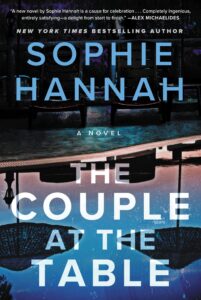
Sophie Hannah, The Couple at the Table
(William Morrow)
Hannah consistently delivers first class mystery, and in her latest a pair of honeymooners receive a chilling note at dinner: “Beware of the couple at the table nearest to yours.” Part whodunnit, part psychological thriller, this one will leave you looking over your shoulder and a little less trustful of those around you.–DM
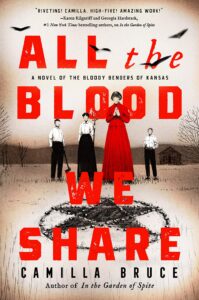
Camilla Bruce, All the Blood We Share: A Novel of the Bloody Benders of Kansas
(Berkley)
Camilla Bruce already impressed me with her novel of a 19th century serial killer, In the Garden of Spite, so I’m pleased to see her returning to the era in All the Blood We Share, this time with even more serial killers! Seriously, there’s a whole family of serial killers in this book. Killing travelers in their roadside inn and dumping the bodies down a chute into the cellar. Just like Sweeney Todd, except the Benders were (unfortunately for their victims, fortunately for historical fiction readers) very real. –MO

D.M. Rowell, Never Name the Dead
(Crooked Lane)
Rowell’s Never Name the Dead is an impressive debut, charting a woman’s return from Silicon Valley to her roots, the Kiowa tribal land in Oklahoma, where she finds a divided tribe, land threatened by fracking, and her own grandfather missing and possibly framed for a crime she knows he didn’t commit. The novel then becomes a detective story with a deep sense of place and history. Rowell brings notes of poetry to the dark tale of corruption. –DM

Mariah Fredericks, The Lindbergh Nanny
(Minotaur)
Mariah Fredericks is an expert at capturing history’s ordinary voices in extraordinary circumstances, and The Lindbergh Nanny is her best yet. Betty Gow didn’t have the best experience with her previous nannying, so she’s shocked and delighted when she gets a job with the famed Lindberghs, even though Charles Lindbergh—and his hands-off child-rearing method—both seem rather cold. Gow is enchanted by her new charge, however, going to great lengths to make up for his parents’ benign neglect, and is devastated when the baby is kidnapped and she finds herself a suspect. An eyewitness view of a still-shocking event that makes for perfect historical fiction. –MO

Erika T. Wurth, White Horse
(Flatiron)
Erika T. Wurth’s White Horse is part horror novel, part detective story, as a haunted woman finds herself compelled to investigate her mother’s long-ago disappearance. Why did her mother leave her at two days old? Why did no one listen to her father when he suspected foul play? How many others have gone missing the exact same way? What is her mother trying to tell her through the visions she sees when she wears her mother’s powerful beaded bracelet? And what is the horrifying presence she’s accidentally conjured into this world, along with her mother’s ghost? White Horse, like the bar in the story it takes its title from, is gritty, haunting, understated, and beautiful. Erika T. Wurth is of Apache, Chickasaw, and Cherokee descent, and sets out to capture the urban Native experience while also doing justice to deeply rooted spiritual beliefs and practices. –MO

Jas Hammonds, We Deserve Monuments
(Roaring Brook Press)
Jas Hammonds’ new book is stunning, and makes for essential reading for anyone who wants to understand the generational trauma of racist violence in the South. Queer biracial teen Avery has to move from busy DC to a small Southern town when her grandmother gets sick, and she doesn’t have much time to build a relationship with her ailing relative. Avery and her ailing relative begin to bond, but Avery’s not sure if she wants to know all the town’s secrets. But learn them she will, even with a budding romance with the girl next door to distract her. –MO
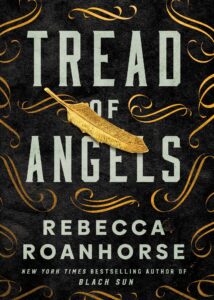
Rebecca Roanhorse, Tread of Angels
(Saga)
In this tough-as-nails novella, Rebecca Roanhorse imagines a late 19th century mining town with a most precious mineral for extraction, inhabited by the descendents of rebellious angels (known as the Fallen) yet exploited from above by those still accepted by heaven (known as the Virtues). Roanhorse plays with the notion of purity and original sin, as her townspeople must grapple with their permanently assigned “rebel” status and the seemingly virtuous come slumming at night to see the town’s most wicked delights. A murder in town threatens to disrupt the fragile peace between Fallen and Virtues, and a demon girl must solve the crime or lose her sister forever to the punishments of heaven’s judgement. Rebecca Roanhorse is known for her incredible worldbuilding, diverse inspirations, and complex reinterpretations of tropes, and all her talents are perfectly on display in her latest. For those who can’t get enough of Roanhorse’s speculative fiction, check out Fevered Star, the sequel to her meso-American indigenous fantasy Black Sun. –MO

Louise Kennedy, Trespasses
(Riverhead)
Set during the Troubles in Northern Ireland, Kennedy’s story follows a woman who comes into the orbit of a charismatic young barrister who has made a name for himself defending IRA members. Their relationship evolves into a fascinating and deeply unsettling pairing amidst the wider political turmoil. –DM

C.L. Polk, Even Though I Knew the End
(Tordotcom)
A supernatural detective who communes with the dead and mingles with the monstrous stars in this stylish noir. Polk’s heroine has echoes of Laurell K. Hamilton’s Anita Blake (but, like, the queer Anita Blake we always wanted), as she sets out to track down the White City Vampire, a serial killer stalking Chicago’s streets. She doesn’t want the job, but if she succeeds, she’ll get a chance to spend the rest of her days with her great love, instead of suffering eternity in hell as consequence of a doomed magical bargain. The setting is historical, although when exactly is up for debate—think “Guys and Dolls”-era but a little bit earlier and also sapphic horror, and you’ll have a good idea of what to expect from this pulptastic novella. –MO

Louise Penny, A World of Curiosities
(Minotaur)
In Penny’s latest, backstories come to light as the world slowly emerges from a long winter. Penny continues her carefully focused character studies of small town life and crafts a clever and complex set of interlocking mysteries whose answers must be found in memories, long and short. A satisfying new entry from a world-class writer. –MO

Eric Gansworth, My Good Man
(FSG)
My Good Man is simultaneously an incisive coming-of-age story, a mystery, and a vivid portrait of life in and around indigenous reservations. A local newspaper and a vicious assault form the backdrop, as Gansworth spins out a story full of nuance and insight. –DM

Lauren Nossett, The Resemblance
(Flatiron)
Like everyone else these days, I can’t get enough of dark academic fiction, and Lauren Nosett’s takes the aesthetic into the frat houses in this college campus thriller. Nossett’s detective protagonist has a mother who’s a professor, lending expertise to her investigation of the university and also providing a source of conflict. The crime propelling The Resemblance is a puzzler: a fraternity brother is run down in the street by a man who looks exactly like him, and everyone in school’s Greek scene appears to have something to hide. –MO

Ausma Zehanat Khan, Blackwater Falls
(Minotaur)
I’m a huge fan of Ausma Zehanat Khan’s Community Policing series set in Canada, so I was psyched to see that she’s bringing her social justice oriented procedurals to the states with a new series taking place in Colorado. In Blackwater Falls, a teenage girl who’s a Syrian refugee is found murdered and posed as the Madonna in a church; it’s up to Khan’s Muslim detective to solve the murder and protect her community from both violent attack and more subtle aggressions. –MO

Roseanne Montillo, Deliberate Cruelty: Truman Capote, the Millionaire’s Wife, and the Murder of the Century
(Atria)
A haunting picture of midcentury America’s social elite, the various murders and suicides that scandalized them, and, coming in from the margins, literary icon Truman Capote. Deliberate Cruelty manages to be a hard-hitting true crime story and an interesting piece of cultural history, bringing out new facets of some well-known personalities to create a shocking story. –DM

Blair Braverman, Small Game
(Ecco)
In this quiet survivalist thriller, a game show in the woods becomes the real deal when an apocalyptic event cuts off the competitors from the rest of the world. Blair Braverman’s wilderness expertise is evident throughout the book, and the ways in which characters must rely on each other to find a path forward are hopeful. The ending itself was fairly open to interpretation, so read the book and talk about it with meeeee…. –MO
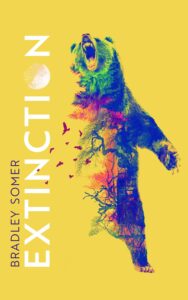
Bradley Somer, Extinction
(Blackstone)
A heart-pounding thriller built out of a ranger’s mission to protect his territory’s last surviving bear against oncoming threats. Somer’s writing is visceral and immediate, and he brings the natural world into focus in fascinating ways. –DM

Anthony Horowitz, The Twist of a Knife
(Harper)
The incomparable detective duo Horowitz and Hathaway are BACK in this fourth installment of their adventures. (If you’re wondering why the detective and the author share a name, it’s because they are the same person. Kind of.) But anyway, in this new installment, Horowitz is the main suspect in a murder, and Hathaway is the only one who can exonerate him. Problem is, they’re not talking.–OR
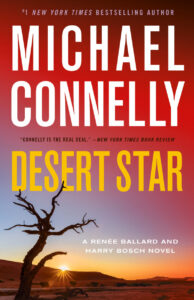
Michael Connelly, Desert Star
(Little Brown)
After a year in the wilderness, Renée Ballard is back with the LAPD, this time taking up a post at the head of a cold case unit in the elite Robbery-Homicide Division. And naturally, she enlists Harry Bosch to bring his own passion project over to her squad. Longtime readers will be glad to know that Connelly is still bringing the same intensity and atmosphere to his iconic series. –DM
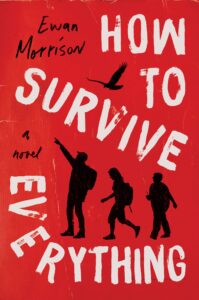
Ewan Morrison, How to Survive Everything
(Harper Perennial)
Morrison’s new novel is a fascinating exploration of the ethics of prepper culture through the eyes of a teenage girl. Along with her young brother, Haley’s been abducted by their disaster-prepping father, who has funded a bunker with what should have gone to child support payments and is convinced they must stay with his motley crew of camo-clad fanatics for at least three years. Did the apocalypse happen? Or is their father completely delusional? Harrowing, humorous, and featuring a clever and resourceful heroine, How to Survive Everything is the perfect book to read down in your bunker ahem, living room. –MO
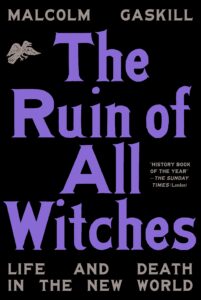
Malcolm Gaskill, The Ruin of All Witches: Life and Death in the New World
(Knopf)
It’s been a great year for witch fiction, both for novels featuring powerful feminist magic and for history books exposing the intense misogyny behind the original witch trials. Gaskill’s The Ruin of All Witches is, of, course, the latter, as we learn of an obscure mid-17th century witch trial in Connecticut with vast implications for the present day. Gaskill paints a claustrophobic portrait of a suspicious, insular, and deeply competitive community ready to turn on each other just as quickly as one could shout “She curdled my milk!”. –MO

Kevin Wilson, Now Is Not the Time to Panic
(Ecco)
Kevin Wilson’s lively new novel is about two off-beat teenagers who unwittingly cause a panic in their small Tennessee town when they create an enigmatic poster that starts appearing all over the neighborhood, seeming to suggest some deeper, darker meaning.–OR
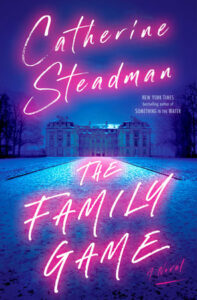
Catherine Steadman, The Family Game
(Ballantine)
This book reminds me a little of the movie Ready or Not, in that it’s about rich and creepy in-laws. Harriet is a young writer with exciting prospects, in love with her fiancé Edward (the estranged heir of the powerful Holbeck family. Even though the couple has remained distant from the family, the family lures them back into their orbit. But then, under the guise of showing Harriet a sample of the book he’s writing, Edward’s father gives Harriet a recording of him confessing to a horrific crime, and plunges them all into a world of danger, deception, judgement, and betrayal. –OR
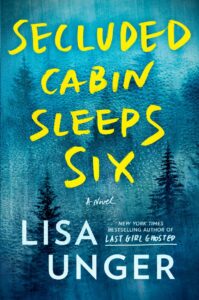
Lisa Unger, Secluded Cabin Sleeps Six
(Harlequin)
Lisa Unger’s clever character study of a crime novel takes place in a secluded luxury rental where six guests (and one interloper) have gathered for a weekend away. Despite the beautiful accommodations, it’s just so hard to relax—the cabin owner is a bit too nosy, the interpersonal dynamics are growing tense, and there’s a storm brewing that’ll keep anyone from escaping…–MO
___________________________________
DECEMBER AND BEYOND
___________________________________
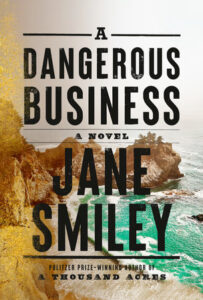
Jane Smiley, A Dangerous Business
(Knopf)
In this Poe-influenced tale (the first of two on this list), Eliza Ripple, a young widow and sex worker, becomes concerned when vulnerable women start vanishing from the brothels of Monterey and no one among the authorities appears to much care. Eliza is also rather curious, and reads quite a bit of detective fiction, so she and her close friend embark on their own investigation. Eliza Ripple and her merry coterie are the kind of characters that feel both true to their age and perfectly at ease in ours, a rare feat for an historical fiction writer to accomplish. Jane Smiley has been writing literary explorations of the human condition for decades, and all of her novels are excellent, but you get the sense that she really had fun writing this one. –MO

Hannah Morrissey, The Widowmaker
(Minotaur)
I loved Hannah Morrissey’s debut, Hello, Transcriber, both for the characters and for the dark ambiance of her setting. Now, she returns to Black Harbor with new characters, for a series that feels like Tana French if she was writing about the town from Red Harvest. By which I mean, things are very, very, bad in Black Harbor. –MO
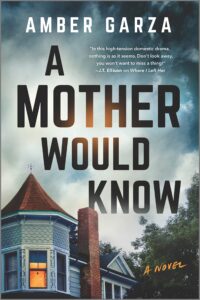
Amber Garza, A Mother Would Know
(Harlequin)
I don’t have kids and it’s a good thing because if I had read this thriller while growing real human beings in my home, I might actually combust from anxiety. Valerie lives alone in a giant Victorian house and her adult daughter is growing worried that she’s becoming forgetful. Valerie decides it might be nice if her grown son comes to live with her, but he’s a bit different when she remembers. And when a woman is murdered nearby and he becomes the logical suspect, Valerie begins to wonder if she raised (and is living with) a killer. So, you know… terrifying. –OR
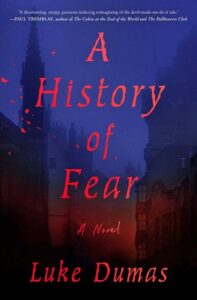
Luke Dumas, A History of Fear
(Atria)
Dumas’s debut is a stunner that will leave readers deeply unsettled. The story follows a young graduate student in Edinburgh, an American now notorious for having confessed to the murder of a classmate, and for claiming he was forced into the deed by the devil, whose presence barged into his life when he was hired to ghost write a strange text. Incorporating elements of horror and mystery, A History of Fear reveals itself slowly and delivers on its ambitious premises. –DM
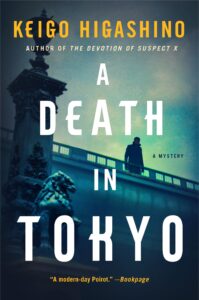
Keigo Higashino, A Death in Tokyo
Translated by Giles Murray
(Minotaur)
In this dark and elegant mystery from master of the genre Keigo Higashino, Tokyo Police Detective Kyoichiro Kaga is faced with a murder where the various bits of evidence do not seem to add up, with clues scattered all over the city. It’s the third in the acclaimed Kyoichiro Kaga series, by the way, so if this is the first time you’re hearing of it, get to the library and take out the first: Malice. You won’t be disappointed.–OR
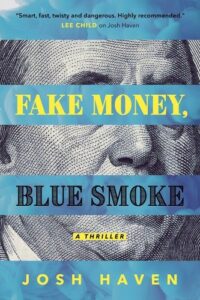
Josh Haven, Fake Money, Blue Smoke
(Mysterious Press)
In this crime debut, a recent ex-con links up with an ex he still carries a torch for, only to be told that she’s given up her career in the arts for one in international currency counterfeiting and laundering. And now she needs his help to make one last score and get out of the game alive. Haven was an art critic and astrogeophysicist, among other professions, and he brings an eclectic array of characters and skills to this clever novel. –DM
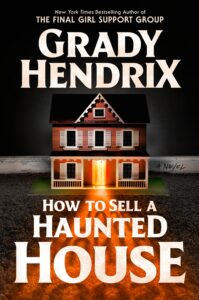
Grady Hendrix, How to Sell a Haunted House
(Berkley)
I am not exaggerating when I say that Grady Hendrix’s Paperbacks from Hell newsletter saved me from losing my sense of humor during the pandemic. His hilarious, metatextual horror fiction is absurdly entertaining, and his new novel, How to Sell a Haunted House, promises to skewer the tropes of hauntings while paying homage to a long history of supernaturally possessed homes. And in a country beset by widely aging housing stock, this book is probably more practical than any of us would like to admit. –MO
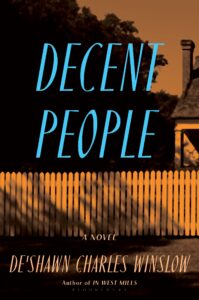
De’Shawn Charles Winslow, Decent People
(Bloomsbury)
In De’Shawn Charles Winslow’s second novel, also set in the deeply divided and very segregated town of West Mills, North Carolina, three siblings are found shot to death soon after Ms. Jo Wright moves back to town, and she’s determined to clear her new paramour of any suspicion. After all, the three siblings were not well liked, and the professional success of one, a doctor, may have made them all targets of racist violence. And everyone in town appears to have secrets…–MO

Deepti Kapoor, Age of Vice
(Riverhead)
Damn, this book is good. And so epic. Like Renoir’s Rules of the Game, this is a perfectly crafted portrait of the moral degradation of the wealthy, as parties and profits grow to replace right and wrong in the minds of the characters. The story is told through three main points of view: Ajay, the servant whose loyalty will prove his undoing, Sunny, the uber-rich addict who wilts under his father’s expectations, and Neda, a journalist who finds herself inextricably entangled with the subject of her own assignment. The ending is shattering. Actually, this whole book is shattering. So instead of watching that colonialist POS known as Shantaram, read this book instead. –MO
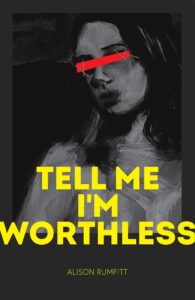
Alison Rumfitt, Tell Me I’m Worthless
(Tor Nightfire)
In this intense haunted house story, three girls spend a night in a property cursed by the hatred and violence of those who first occupied its grounds. One is trapped in the house forever, and the other two barely escape, the house’s dark powers having revealed both their vulnerabilities and hatreds to each other. Rumfitt uses body horror and the tropes of the haunted house skillfully to explore the trans experience in an England full of terfs, and Tell Me I’m Worthless contains a strong anti-fascist message for a nation beset by growing prejudices. –MO
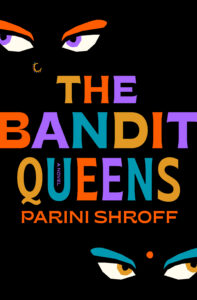
Parini Shroff, The Bandit Queens
(Ballantine)
This book is so much fun! In Parini Shroff’s dark comedy The Bandit Queens, the put-upon women of a small Indian village decide to get rid of their husbands—permanently. The plotting begins when Geeta, a village outcast with an undeserved reputation for killing her own husband, is asked by a fellow member of her economic cooperative for some help in disposing of a violent partner. Things quickly spiral out of control as the bodies start piling up, the police get curious, and Geeta enters into a second-chance romance with a quiet widower who runs a speakeasy. And there’s a dog! What’s not to love? –MO
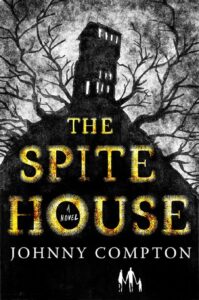
Johnny Compton, Spite House
(Tor Nightfire)
Eric Ross and his two daughters are on the run and looking to settle down somewhere where they won’t be too scrutinized. Enter the Spite House, a haunted house on a hill overlooking an abandoned orphanage, whose owner is looking for a new caretaker to help prove definitely that the house is occupied by ghosts. If Eric can stay in the house long enough to get proof of paranormal activity, he and his daughters will receive enough funds to go completely off the grid. But given the home’s propensity to rob its previous caretakers of their sanity, it’s a toss-up—will Eric find safety for his family, or has he placed them in more danger than ever before? Another great entry into the horror revival, and one of several gothic works on this list by Black authors. –MO
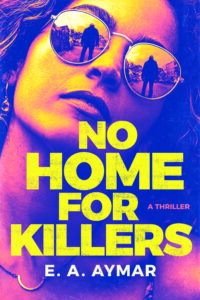
E. A. Aymar, No Home For Killers
(Thomas & Mercer)
After their brother is found murdered, two sisters must work together to find out the truth behind his murder. One is a straight-laced lawyer, but the other, one of the most charming new characters I’ve come across in a long time, is a cheerful psychopath bent on seeking vengeance (or as she likes to think of herself, a vigilante). –MO
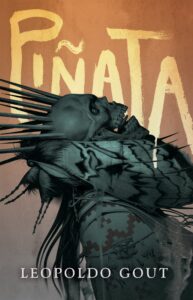
Leopoldo Gout, Piñata
(Tor Nightfire)
This stunningly crafted possession novel is rooted in Aztec history and Nahua religious practice, with an ancient Aztec vessel as the conduit for a powerful spirit seeking to avenge the victims of colonialism. Piñata follows an architect and her two daughters, first in Mexico City, then in New York City, pursued by the spirit all the while, as Gout examines the classic possession tale—an adolescent girl, given powers through her liminal state—and reframes it as a response to racism and the erasure of history and culture. –MO
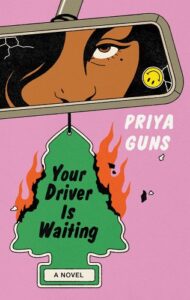
Priya Guns, Your Driver Is Waiting
(Doubleday)
Pitched as a reverse Taxi Driver by the publisher, Priya Guns’ darkly humorous satire follows a South Asian rideshare driver through her days dealing with passengers’ microaggressions, drunkards’ vomit, and an epidemic of bad tippers. Things go from bad to worse after she meets a femme fatale in the form of a white self-proclaimed ally who turns out to be nothing of the sort. –MO
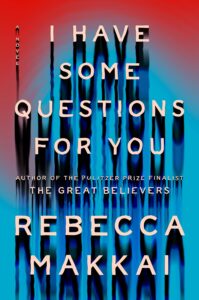
Rebecca Makkai, I Have Some Questions For You
(Viking)
I was sure the true crime podcast novel was dead by now—at least, until I picked up Rebecca Makkai’s latest, which completely revitalizes this common trope. A professional podcaster returns to the private school she once attended to teach a two week seminar on podcasting and journalism; one of her students decides to investigate a 90s-era murder that the podcaster was much closer to than she lets on to her students. Every year, I look for the novels that truly respect their victims, and think carefully about the tropes of true crime; for 2023, this is that novel. –MO

Margot Douaihy, Scorched Grace
(Zando, Gillian Flynn Books)
Margot Douaihy’s chain-smoking nun Sister Holiday may be the most original character you’ll come across for quite some time. Douaihy wanted to reclaim pulp tropes for a female protagonist, and I have to say, Sister Holiday is punk AF. Set in New Orleans, Scorched Grace takes place at a Catholic school where an arson attack has harmed several students. Sister Holiday, a fan of detective fiction, is ready to solve the case (or else face suspicion herself). –MO

Eli Cranor, Ozark Dogs
(Soho)
Eli Cranor is back in 2023 with the follow-up to his widely acclaimed debut, Don’t Know Tough. The new novel, which traces a volatile history of violence between two families, is a powerful portrait of love, revenge, and trauma. Cranor paints a vivid Ozark landscape and populates it with characters who jump off the page and demand your attention. Ozark Dogs establishes Cranor as a premier crime writer and on the rise. –DM
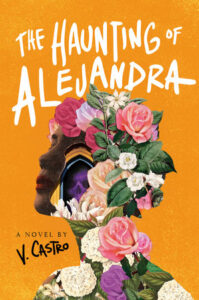
V. Castro, The Haunting of Alejandra
(Del Rey)
V. Castro’s heroine is haunted by the spirit of La Llorena—or, at least, an ancient evil that has found a way to embody a folk legend. She must go to a curandera and process her personal and generational trauma before she can even hope to be free of the demon possessing her, in what also functions as a perfect metaphor for clearing the fog of depression and seeing the societal structures and history that contribute to our present-day malaise. –MO

